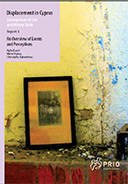Over the course of two decades, more than 220,000 Cypriots lost their homes and properties, initially as a result of inter-communal violence in the 1950s and 1960s and later because of the war and subsequent division of the island in 1974. Property issues arising from these past internal displacements have become intertwined with the competing political and geostrategic aims of the two Cypriot communities, and have thus remained unresolved to this day. Moreover, with the passage of time these issues have turned into legally and technically the most complicated part of the Cyprus dispute; they are also central to economic and social considerations in the event of a peace agreement.
Significantly, the issue of displaced persons’ rights also has a complex emotional aspect. This is because it has had, and continues to have, a direct impact on the lives of individuals and local communities, more than any other aspect of the Cyprus problem. Most Cypriots link the issue of displaced persons’ rights with the wrongs done to them by the other community; the loss of homes, property and livelihoods; ancestral lands; original habitats and cultural artefacts; and the social life that surrounded them. Thus, there are highly emotive, normative and personal sentiments surrounding the issue. These sentiments will not fade away quickly and probably will continue to frame collective imaginations even after a formal solution of the issue is attained, complicating the implementation of such a solution.
This report presents an overview of the various phases of population displacements in Cyprus, as well as a synopsis of the political, legal, social and psychological consequences of conflict-related displacement.
Also available in the following languages:









